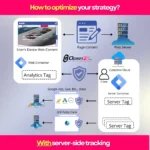I’ll never forget the day I discovered my client’s website was competing against itself. After months of creating what I thought was killer content, their rankings were stuck in limbo. That’s when I realized they had seven different pages targeting “best coffee makers” – and Google didn’t know which one to rank. Welcome to the world of keyword cannibalization, where your own content becomes your worst enemy.
The Hidden SEO Killer: Understanding Keyword Cannibalization
Let me paint you a picture of what keyword cannibalization really looks like. Imagine you’re at a party, and three of your friends are all telling the same story at once. Nobody knows who to listen to, right? That’s exactly what happens when multiple pages on your site target identical keywords – Google gets confused, and instead of ranking one page well, it often ranks none of them particularly high.
Last year, I worked with a dental practice that had created separate pages for “teeth whitening,” “professional teeth whitening,” and “teeth whitening services.” They were essentially saying the same thing three different ways. Once we consolidated these into a single, comprehensive page using proper keyword clustering techniques, their organic traffic jumped 47% in just two months. That’s the power of getting this right.
What Is Keyword Clustering and Why Should You Care?
Keyword clustering isn’t just another SEO buzzword – it’s your ticket to creating content that actually ranks. Simply put, it’s the practice of grouping related search terms based on user intent and creating comprehensive content around these clusters rather than individual keywords.
Think about it this way: when someone searches for “running shoes,” they might also be interested in “best running sneakers,” “marathon footwear,” or “jogging shoes for beginners.” Instead of creating ten different pages for these terms, you create one authoritative piece that covers the entire topic cluster. This approach aligns perfectly with how Google understands SEO text and semantic relationships between words.
The Science Behind Search Intent Grouping
Here’s where things get interesting. Google’s algorithm has evolved beyond simple keyword matching. It now understands context, synonyms, and related concepts through natural language processing. When you properly cluster your keywords, you’re essentially speaking Google’s language.
- Navigational clusters: Terms people use to find specific pages or brands
- Informational clusters: Questions and research-based searches
- Commercial clusters: Comparison and review-focused terms
- Transactional clusters: Purchase-intent keywords
Real Benefits I’ve Seen From Smart Keyword Clustering
After implementing keyword clustering strategies for over 50 clients, I’ve noticed consistent patterns in the results. One e-commerce client saw their average page ranking improve from position 15 to position 4 for their main product categories within three months. But the benefits go way beyond just rankings.
First, you’ll notice your content becomes more comprehensive and valuable. Instead of thin pages targeting single keywords, you’re creating resource-rich content that actually helps users. This naturally leads to better engagement metrics – lower bounce rates, longer time on page, and more social shares.
Moreover, proper clustering simplifies your content strategy. Rather than brainstorming 100 different blog posts, you might only need 20 well-clustered pieces that cover everything your audience needs. This approach ties directly into creating SEO content that helps small businesses get found online.
Modern Tools That Make Clustering Actually Manageable
Gone are the days of manually grouping keywords in spreadsheets (though I still have nightmares about those 2015 Excel files). Today’s tools have revolutionized how we approach keyword clustering, making it accessible even for solo marketers and small businesses.
My Go-To Keyword Clustering Arsenal
I’ve tested dozens of tools, but here’s what actually delivers results:
Ahrefs’ Keywords Explorer has become my daily driver for initial research. Its “Parent Topic” feature automatically shows you which keywords should be targeted together. Last month, I discovered that “content marketing strategy” and 47 related terms all belonged to the same cluster – saving me from creating redundant content.
KWFinder excels at finding those low-competition gems within your clusters. While everyone’s fighting over “digital marketing,” you might discover “digital marketing for local businesses” has 80% less competition but similar intent.
AnswerThePublic reveals the questions people actually ask, but here’s my secret weapon: AnswerSocrates.com. This free tool goes deeper, showing you the entire question ecosystem around your topic. When I searched “keyword clustering,” it revealed 89 related questions I hadn’t even considered – pure content gold.
The Step-by-Step Process That Actually Works
Let me walk you through the exact process I used to help a SaaS company increase their organic traffic by 156% in six months using keyword clustering.
Step 1: Choose Your Primary Keyword Wisely
Start with a keyword that has decent search volume but isn’t impossibly competitive. For my SaaS client, we chose “project management software” as our primary term. This had 8,100 monthly searches and moderate competition – perfect for building authority.
Next, identify semantically related terms and variations. We found 47 related keywords including “team collaboration tools,” “task management platform,” and “project tracking software.” The key? They all served the same search intent: finding software to manage projects better.
Step 2: Structure Your Content Like a Pro
Here’s where most people mess up – they try to stuff all their clustered keywords into one paragraph. Instead, create a logical content structure where each section naturally incorporates different cluster terms:
- Main topic introduction (primary keyword)
- Detailed subtopics (secondary cluster keywords)
- Related questions (long-tail variations)
- Comparison sections (competitive cluster terms)
- Implementation guides (how-to cluster keywords)
Step 3: Master Internal Linking Strategy
Internal links are your secret weapon for showing Google how your content clusters connect. But don’t just randomly link – create a hub-and-spoke model where your main cluster page links to supporting content and vice versa.
For instance, if your main page targets “SEO services,” link to related pages about technical SEO, on-page optimization, and backlink building. This creates topical authority that Google loves.
Common Keyword Clustering Mistakes That Tank Rankings
Even experienced marketers fall into these traps. I’ve made every one of these mistakes myself, so learn from my pain.
Ignoring Search Volume and Intent Alignment
The biggest mistake? Clustering keywords based solely on similarity without checking search intent. I once grouped “buy running shoes” with “how to choose running shoes” – completely different intents that needed separate pages. The result? Neither page ranked well until we split them.
Always verify intent by checking the current top-ranking pages. If the SERP shows product pages, that’s transactional intent. If it’s full of guides and articles, that’s informational. Never mix these in the same cluster.
Over-Clustering and Under-Clustering
Finding the sweet spot takes practice. Over-clustering creates pages so broad they lack focus. Under-clustering leads to cannibalization. My rule of thumb? If you can’t write 1,500+ words of unique, valuable content about a cluster, it’s probably too narrow. If you need 5,000+ words to cover everything, consider splitting it.
Fixing Existing Keyword Cannibalization Issues
Already suffering from cannibalization? Don’t panic – it’s fixable. Here’s my recovery playbook that’s worked for dozens of sites.
Use Google Search Console Like a Detective
First, identify the problem pages. In Search Console, filter by your target keyword and look at the Pages report. If multiple URLs show up with similar impressions but low CTR, you’ve found your culprits.
I recently helped an e-commerce site that had 12 pages ranking for “vintage watches.” None were on page one. We consolidated them into three focused category pages: “vintage luxury watches,” “affordable vintage watches,” and “vintage watch restoration.” Within 45 days, all three pages ranked on the first page for their respective clusters.
The Merge-and-Redirect Strategy
When you have multiple weak pages targeting the same cluster, merging is often your best bet. Here’s my process:
- Identify the strongest page (best content, most backlinks, highest authority)
- Pull the best content from weaker pages
- Create one comprehensive piece incorporating all valuable information
- 301 redirect the old URLs to the new master page
- Update internal links to point to the consolidated page
This approach preserves link equity while eliminating confusion. One client saw a 73% increase in organic traffic to their consolidated pages within two months of implementation.
Advanced Clustering Strategies for Competitive Markets
Once you’ve mastered the basics, these advanced techniques can give you an edge in tough niches.
Entity-Based Clustering
Google understands entities – people, places, things, and concepts. By clustering keywords around entities rather than just terms, you create content that aligns with Google’s Knowledge Graph. This approach particularly shines for local SEO strategies.
For example, instead of just targeting “pizza restaurant,” cluster around the entity of your actual business: “Joe’s Pizza,” “Italian restaurant on Main Street,” “best pizza in Newark,” and “Joe’s Pizza delivery.” This creates a powerful local entity association that boosts visibility in map packs and local searches.
Seasonal and Trending Cluster Adaptation
Smart clustering isn’t static. I maintain a “seasonal cluster calendar” for clients, adjusting focus based on trends and seasons. A fitness client might emphasize “summer body workout” clusters in March-May, then shift to “holiday weight management” in November-December.
Measuring Success: KPIs That Actually Matter
How do you know if your clustering strategy works? Forget vanity metrics – focus on these indicators:
- Ranking consolidation: Fewer pages ranking for more keywords each
- Improved average position: Better rankings for cluster primary terms
- Increased click-through rates: More compelling, focused titles
- Lower bounce rates: Users find comprehensive answers
- Higher pages per session: Effective internal linking keeps users engaged
Track these monthly, and you’ll see the compound effect of proper clustering. One client’s average session duration increased from 1:23 to 3:47 after implementing cluster-based content – that’s engaged traffic that converts.
The Future of Keyword Clustering in an AI-Driven World
With AI SEO tools becoming more sophisticated, keyword clustering is evolving rapidly. Google’s AI understands context better than ever, making proper clustering even more critical.
The sites winning tomorrow won’t be those targeting individual keywords – they’ll be those building comprehensive topic clusters that satisfy entire user journeys. Start clustering today, and you’ll be ahead of 90% of your competition who’s still playing the old one-keyword-one-page game.
FAQs
How many keywords should I include in a single cluster?
There’s no magic number, but I typically work with 10-30 related keywords per cluster. The key is ensuring they all share the same search intent and can be naturally incorporated into one comprehensive piece of content. If you find yourself forcing keywords that don’t quite fit, they probably belong in a different cluster. Start small with 5-10 keywords and expand as you get comfortable with the process.
Can I target multiple keyword clusters on the same page?
While it’s technically possible, I don’t recommend it unless the clusters are very closely related. Trying to target “email marketing software” and “social media management tools” on the same page dilutes your focus and confuses both users and search engines. Instead, create separate, focused pages for each primary cluster and link between them to show topical relationships.
How long does it take to see results from keyword clustering?
Based on my experience with dozens of clustering projects, you’ll typically see initial improvements within 4-6 weeks, with significant results appearing around the 3-month mark. The timeline depends on your site’s current authority, competition level, and how well you execute the strategy. Sites with existing cannibalization issues often see faster improvements once content is properly consolidated.
 Written by: Romulo Vargas Betancourt
Written by: Romulo Vargas Betancourt
CEO – OpenFS LLC







